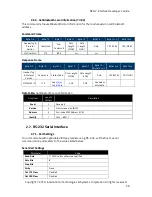
NEO 2 Interface Developer’s Guide
Copyright © 2019, International Technologies & Systems Corporation. All rights reserved.
47
After a card is detected, the terminal may use one of the Pass-Through commands to
communicate with the card at the application level and read the data.
Additional Pass-Through commands allow a terminal to use low-level features provided by
the ViVOpay reader, such as controlling the RF antenna (field).
3.2.2.
Pass-Through Command Frame Format
Byte 0-9
Byte 10
Byte 11
Byte 12
Byte 13
Byte 14 …
Byte 14+n-1
Byte
14+n
Byte
15+n
Header Tag &
Protocol
Version
Command
Sub-
Command
Data
Length
(MSB)
Data
Length
(LSB)
Data
CRC
(MSB)
CRC (LSB)
ViVOtech2\0
See
Individual
Commands
See
Individual
Commands
See
Individual
Commands
See
Individual
Commands
See Individual
Commands
Note
: Within each Pass-Through Frame Type, the CRC is stored as big-endian number; that
is, higher byte (MSB) first.
3.2.3.
Pass-Through Response Frame Format
Byte 0-9
Byte 10
Byte 11
Byte 12
Byte 13
Byte 14 …
Byte 14+n-1
Byte 14+n Byte 15+n
Header Tag
& Protocol
Version
Command Status Code
Data Length
(MSB)
Data Length
(LSB)
Data
CRC (MSB) CRC (LSB)
ViVOtech2\
0
See
Individual
Commands
See
Individual
Commands
See
Individual
Commands
See
Individual
Commands
See Individual
Commands
3.2.4.
Suggested Sequence for Pass-Through Commands
1.
Put the ViVOpay reader in Pass-Through Mode by sending a
command.
2.
Periodically request the ViVOpay reader to poll for cards by sending the
Poll for Token
command. If no card is found within the time specified, the ViVOpay reader indicates
this with a timeout error. If a card is found, it returns the card type and serial number.
3.
At this point, the ViVOpay reader has already gone through the anti-collision, selection,
and activation sequence (if required) as per ISO 14443 A/B, and the card is ready for
communication. Depending on the card type, use the appropriate Pass-Through
commands to communicate with the card. Card types and the applicable commands
are listed below.






























